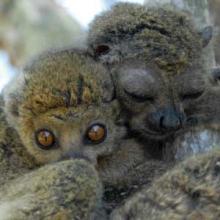Avahi cleesei has a head-body length of 23–31 cm, a tail length of 32–36 cm, a total length of 55.2–67.5 cm, and a weight of 750–1,300 g (Thalmann and Geissmann, 2005; Zaramody et al., 2006; Lei et al., 2008). The face is slightly paler than the forehead and crown, and the triangular upward extension of the facial area onto the crown contrasts with the triangular downward extension of the crown into the facial area that is seen in Avahi occidentalis and Avahi unicolor. The fur of the forehead immediately above the face is blackish, forming a dark chevron pattern. The eyes are maroon and have black, hairless eyelids. The snout is black and hairless. Fur at the corners of the mouth is whitish. Head and body fur are brown-gray and woolly. The tail varies from brownish-gray to beige and is slightly reddish on the dorsal surface near its base. Fur of the ventral surface is thin and light gray. Characteristic white patches are found on the dorsal surface of the hindlimbs.
The Bemaraha woolly lemur is most likely to be confused with other western woolly lemurs, but it is not sympatric with them so this would not be a problem in the field. It differs from Avahi occidentalis by its lack of a white facial mask and dark eye-rings, and from both Avahi occidentalis and Avahi unicolor by the presence of a dark chevron on the forehead (Thalmann and Geissmann, 2000). It could be confused with Lepilemur and, to a lesser extent, Cheirogaleus medius. However, it is much larger than Cheirogaleus and quite different in its postural and locomotor behavior, and can usually be distinguished from Lepilemur by its less conspicuous ears, denser, curlier coat, and obvious white thigh patches.
Zaramody et al. (2006) suggested that A. cleesei could be a junior synonym of A. occidentalis. However, its validity as a species was reaffirmed by Andriantompohavana et al. (2007) and by Lei et al. (2008).
